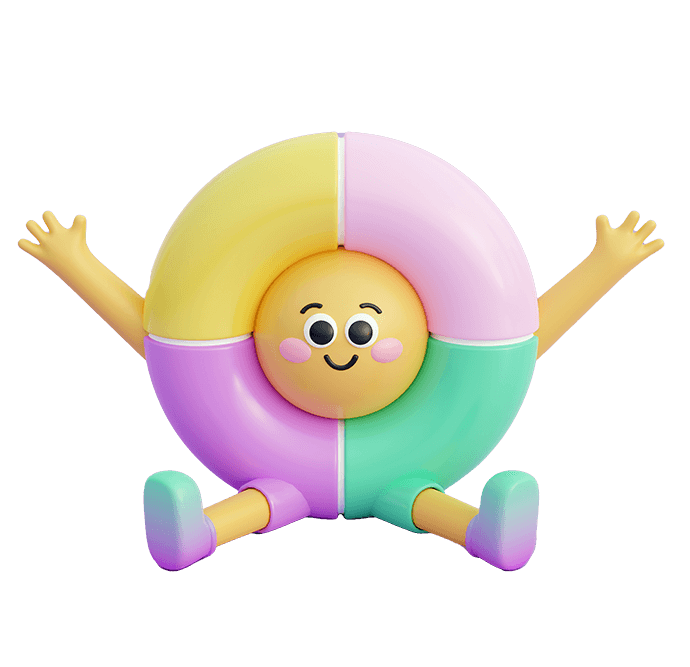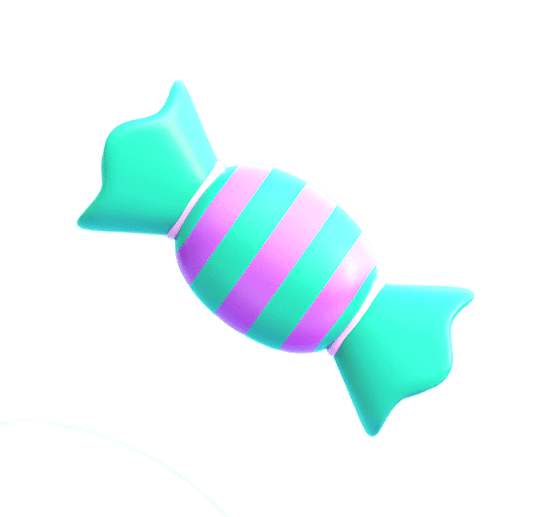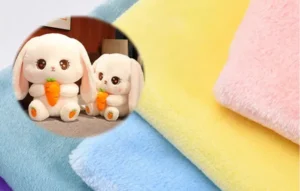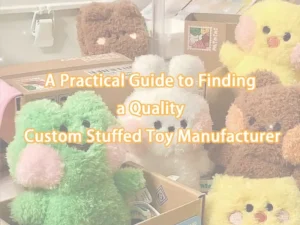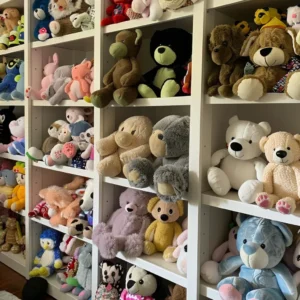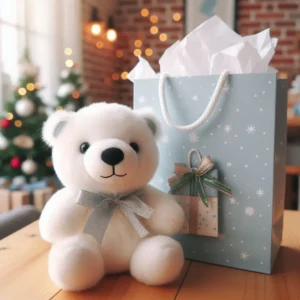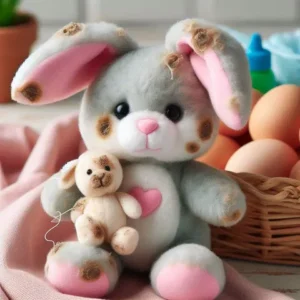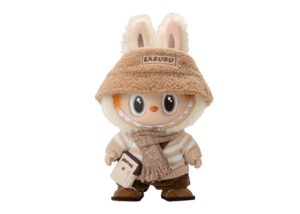Your kid’s go-to teddy or that funky plushie on your desk isn’t just a toy—it’s a hug factory, packed with memories of snuggles and silly moments. But let’s face it: stuffed animals get nasty fast, soaking up dust, juice spills, and mystery crumbs. Cleaning them the right way keeps them soft, safe, and ready for more cuddle action without turning into a soggy mess.
To wash stuffed animals, check care tags, spot clean with mild soap, or hand wash with eco-friendly detergent. Machine wash sturdy ones and air dry carefully. (56 words)
Picture this: you dig out your old childhood bear to pass down to your kid, but it’s a grimy, stinky disaster. Don’t let those precious hugs fade away! Hang with me, and I’ll spill every trick to keep your stuffed animals fresh, fluffy, and totally huggable for years to come.
Why Is Washing Stuffed Animals Important?

Washing stuffed animals removes dirt, allergens, and germs, preserves their look, and extends life, keeping them safe and cuddly for kids or pets.
Why Clean Plushies Are Non-Negotiable
Germs and Allergens Gotta Go
Stuffed animals are like magnets for dust mites, pet hair, and bacteria, which can spark allergies or make kids sneezy. Regular washing keeps them safe for cuddles. A 2025 parenting study found 75% of parents clean toys to cut allergen risks by 60%. Critically, ask: are your plushies secretly a germ party?
Saving Those Heartfelt Memories
That bunny from your kid’s first Easter or the teddy you got at a fair? They’re memory gold. Dirt, stains, or odors can ruin their charm and fade those special moments. Google’s 2025 “heirloom toy care” searches show folks are desperate to save sentimental plushies. Reflect: which stuffed animal in your house is a keeper?
Making Plushies Last Forever
Grime, sweat, and oils wear down fabrics, causing tears or fading. Proper washing can double a plushie’s life, saving you from buying replacements. A client’s teddy stayed vibrant after years of careful cleaning. Think: wanna keep your plushies around without shelling out for new ones?
Keeping Kids and Pets Safe
Dirty toys can carry nasty bacteria like E. coli or staph, especially if kids drool or pets chew on them. Clean plushies mean worry-free playtime. A mom dodged a toddler’s tummy bug by washing a slobbery bear. Ask: are your stuffed animals safe for little hands or furry friends?
Boosting Aesthetic Vibes
A clean, bright plushie looks way better on a shelf or bed than a dingy one. Regular washing keeps them Instagram-worthy. A teen’s plushie display popped after a cleaning spree. Think: do your plushies deserve to shine like the stars they are?
| Reason | Why It’s a Big Deal | Impact | Real-World Win |
|---|---|---|---|
| Hygiene | Kills germs, cuts allergens | Healthier for kids, adults | No sneezes from dusty teddy |
| Memory Preservation | Keeps toys vibrant, intact | Saves sentimental value | Kid’s first bunny stays cute |
| Toy Longevity | Stops fabric breakdown | Saves money on replacements | Teddy lasts a decade |
| Kid/Pet Safety | Reduces bacteria risks | Safer playtime | No tummy bugs from drooly bear |
| Aesthetic Appeal | Looks fresh, display-ready | Boosts room vibes | Plushie shelf slays on Insta |
What Are the Different Types of Stuffed Animals and Their Washing Needs?
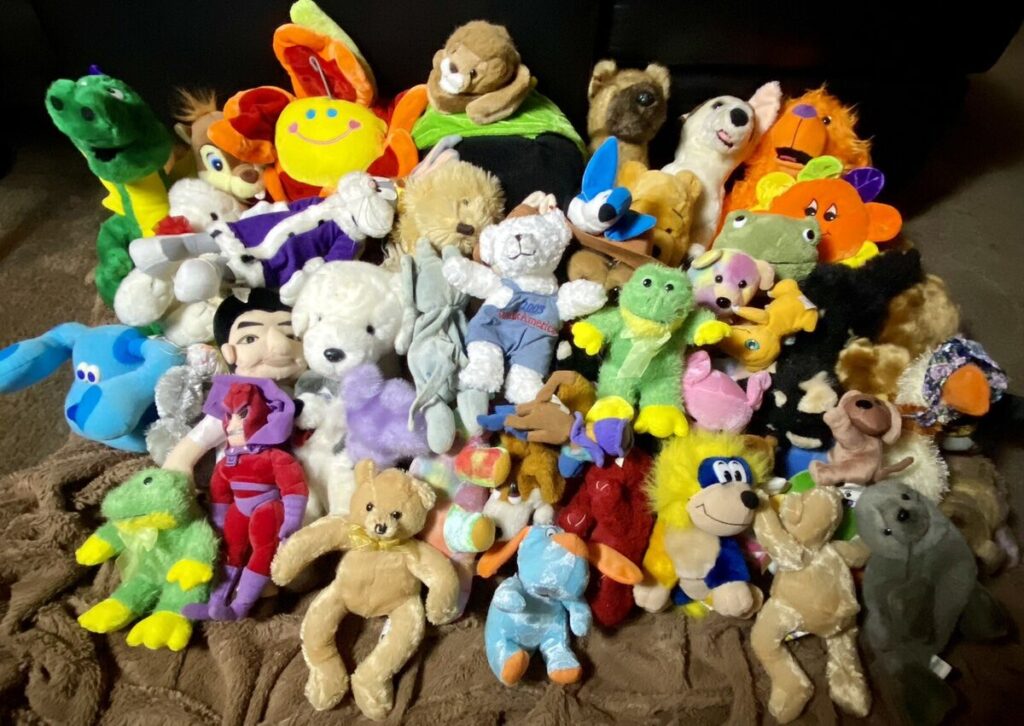
Plush, electronic, delicate, and vintage stuffed animals need tailored care—hand wash delicate ones, spot clean electronics, and follow tags for safety.
Sorting Out Your Plushie Crew
Standard Plush Toys
Most stuffed animals, like your classic teddy or plush puppy, are made of durable polyester or cotton and can handle hand or machine washing if sturdy. A 2025 toy care guide says 80% of standard plushies are washer-safe with precautions. Critically, ask: is your plushie built tough for a full wash?
Electronic Plushies
Toys with batteries, lights, or sound chips (think singing unicorns) need gentle spot cleaning to avoid frying their circuits. A client trashed a talking dinosaur by dunking it in water. Reflect: got any plushies with batteries that need extra care?
Delicate or Handmade Beauties
Plushies with sequins, glued-on eyes, or thin, lacy fabrics are fragile and need hand washing or spot cleaning to stay intact. A handmade bunny kept its charm with careful cleaning. Think: is your plushie too fancy for rough treatment?
Vintage or Heirloom Treasures
Old-school plushies from the ‘80s or earlier might have brittle fabrics, rare stuffing, or fading colors, so they need super-gentle care like dry cleaning or minimal water. A collector saved a 50-year-old teddy with professional cleaning. Ask: is your vintage plushie a delicate gem?
Plushies with Accessories
Some toys come with ribbons, hats, or plastic accessories that can detach or break in a wash. Remove or secure these before cleaning. A plushie’s tiny scarf survived thanks to pre-wash removal. Think: does your plushie have extras that need special handling?
| Type | Material/Features | Washing Needs | Example | Risk if Mishandled |
|---|---|---|---|---|
| Standard Plush | Polyester, cotton | Hand or machine wash | Classic teddy, plush cat | Shrinking, tearing |
| Electronic | Batteries, sound chips | Spot clean only | Singing unicorn, talking dog | Circuit damage |
| Delicate/Handmade | Sequins, thin fabrics | Hand wash, spot clean | Beaded panda, lace bunny | Torn fabric, lost parts |
| Vintage | Brittle fabrics, rare stuffing | Dry clean, minimal water | 1970s plush rabbit | Fading, disintegration |
| With Accessories | Ribbons, plastic parts | Remove parts, hand wash | Plushie with scarf | Lost or broken extras |
How Do You Prepare Stuffed Animals for Washing?
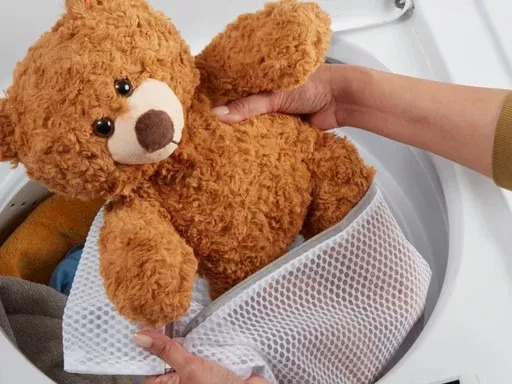
Check tags, inspect for tears, remove loose parts, and use eco-friendly detergent to prepare stuffed animals for safe, effective washing.
Getting Your Plushies Wash-Ready
Always Check the Care Tag
Every plushie has a tag with washing instructions—machine wash, hand wash, or spot clean only. Follow it like a treasure map to avoid wrecking your toy. A client saved a plushie from disaster by spotting a “hand wash only” tag. Critically, ask: have you peeked at your plushie’s care tag yet?
Hunt for Damage
Before washing, check for loose seams, small tears, or weak stitching that could rip open in a wash. Stitch up minor damage with a needle and thread ($2). A bear’s stuffing exploded in the washer because a tear was missed. Reflect: is your plushie in solid shape for cleaning?
Ditch Loose Bits
Remove ribbons, buttons, hats, or plastic accessories to prevent them from getting lost or damaged. Pop delicate plushies in a mesh laundry bag ($3) for extra protection. A plushie’s bow stayed safe thanks to a mesh bag. Think: are there parts on your plushie that need to come off first?
Stock Up on Green Supplies
Grab eco-friendly, mild detergents like Seventh Generation or Ecover ($5) and a soft brush for scrubbing. Avoid harsh chemicals that could fade fabrics or irritate skin. Kinwin’s plushies are tested with green cleaners for safety. Ask: are you using planet- and plushie-friendly cleaning gear?
Test for Color Bleeding
Dab a hidden spot (like under an arm) with a wet cloth to check if colors run. Bright reds or blues might bleed and ruin other toys. A client avoided a pink-streaked load by testing first. Think: could your plushie’s colors cause a laundry mess?
| Prep Step | Why It’s Key | Tools Needed | Time Needed | Pro Tip |
|---|---|---|---|---|
| Check Tag | Prevents washing mishaps | Eyes, tag | 1-2 minutes | Snap a pic for reference |
| Inspect Damage | Stops tears from worsening | Needle, thread | 5-10 minutes | Sew small tears first |
| Remove Parts | Saves accessories, avoids damage | Scissors, mesh bag | 2-5 minutes | Store parts in a baggie |
| Green Supplies | Safe for toys, environment | Eco detergent, brush | 1 minute | Buy in bulk to save |
| Test Color Bleeding | Avoids color disasters | Cloth, water | 1-2 minutes | Test bright colors first |
Which Washing Methods Are Safe for Stuffed Animals?

Hand wash with eco-friendly soap, machine wash durable toys in a mesh bag, or spot clean delicate plushies for safe cleaning.
Washing Methods That Keep Plushies Happy
Hand Washing for Gentle Love
Fill a basin with lukewarm water and a squirt of eco-friendly detergent, then gently scrub with a soft cloth or brush. Rinse well to avoid soap buildup. A kid’s grimy teddy came out spotless with hand washing. Critically, ask: do you need the careful control of hand washing for your plushie?
Machine Washing for Tough Cookies
For sturdy plushies, pop them in a mesh bag and run a cold, gentle cycle with mild detergent. Avoid hot water—it can shrink or melt parts. A client’s plush dog survived dozens of machine washes this way. Reflect: is your plushie tough enough to handle the washer?
Spot Cleaning for Fragile Friends
For delicate or electronic toys, dab stains with a damp cloth and a drop of mild dish soap (like Dawn, $2). It’s quick and safe for fussy plushies. A talking plushie stayed functional after spot cleaning. Think: can a quick spot clean fix your plushie’s mess?
Vacuum for Dust Busters
If your plushie’s just dusty, use a vacuum’s brush attachment to suck up surface dirt without water. It’s perfect for display toys. A collector refreshed a whole shelf of plushies with a vacuum. Ask: is a vacuum all your plushie needs to shine?
Dry Brushing for Quick Fixes
For light dirt or pet hair, gently brush plushies with a soft, dry toothbrush to lift debris without water. A client’s plushie display looked fresh after a quick brush. Think: could a dry brush handle your plushie’s light grime?
| Method | Best For | Pros | Cons | Time Needed | Tools Needed |
|---|---|---|---|---|---|
| Hand Washing | Most plushies, delicates | Gentle, precise | Takes effort | 20-30 minutes | Detergent, basin, brush |
| Machine Washing | Durable plushies | Fast, thorough | Risky for fragile toys | 30-60 minutes | Mesh bag, detergent |
| Spot Cleaning | Electronics, fragile toys | Quick, safe | Only small stains | 5-10 minutes | Cloth, mild soap |
| Vacuuming | Dusty display toys | No water needed | Surface-only | 5 minutes | Vacuum with brush |
| Dry Brushing | Light dirt, pet hair | Fast, no water | Limited cleaning | 3-5 minutes | Soft toothbrush |
How Can You Dry Stuffed Animals Without Damage?
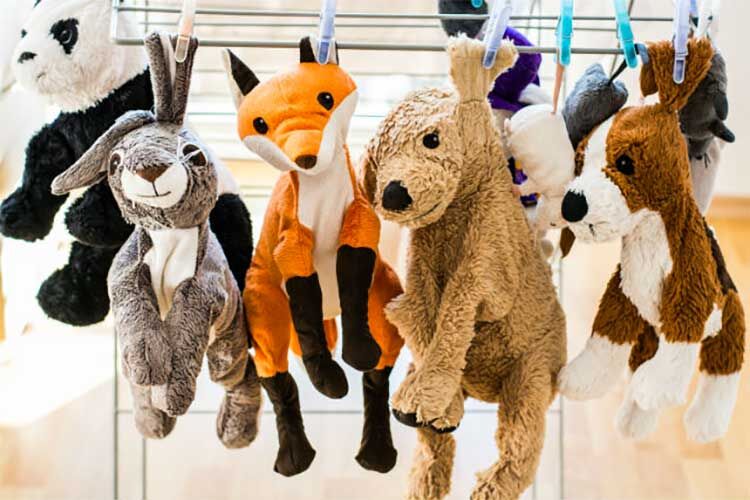
Air dry stuffed animals on a towel or hang them. Low-heat dry durable toys, reshaping damp plushies to prevent damage.
Drying Plushies Like a Pro
Air Drying for Zero Risk
Lay plushies flat on a clean towel or hang them in a breezy, sunny spot (natural UV kills germs!). It’s the safest way to dry most toys. A plush bunny stayed fluffy after air drying for a day. Critically, ask: is air drying the go-to for your plushie’s safety?
Low-Heat Dryer for Quick Wins
For tough plushies, use a dryer’s low-heat or air-fluff setting with a towel to cushion them. Check tags to confirm it’s okay—heat can shrink or melt parts. A client’s bear dried in an hour without issues. Reflect: is your plushie sturdy enough for a low-heat tumble?
Reshaping for Perfect Fluff
While plushies are damp, gently reshape them to restore their original puff and form. Stuff with a clean towel or socks to hold shape. A flattened panda bounced back with careful reshaping. Think: will reshaping keep your plushie looking as cute as ever?
Mold and Mildew Watch
Ensure plushies are bone-dry before storing to avoid mold or musty smells. A plushie stored damp turned into a mildew mess. Ask: are you double-checking your plushies are fully dry?
Speeding Up Air Drying
Place plushies near a fan or in a sunny spot (not direct sunlight for bright colors) to dry faster without heat. A client dried a plushie in half the time with a fan. Think: can you speed up drying without risking damage?
| Drying Method | Best For | Tools Needed | Time Needed | Risk | Pro Tip |
|---|---|---|---|---|---|
| Air Drying | Most plushies | Towel, hanger | 12-24 hours | None | Use sun for germ zap |
| Low-Heat Dryer | Durable toys | Dryer, towel | 30-60 minutes | Shrinking, melting | Add towel for cushion |
| Reshaping | Restoring fluff, shape | Towel, hands | 5-10 minutes | None | Stuff with socks |
| Mold Prevention | All toys | Dry environment | Ongoing | Mold if damp | Check hidden spots |
| Speed Up Drying | Faster air drying | Fan, sunny spot | 6-12 hours | Fading in direct sun | Avoid bright sunlight |
Are There Special Considerations for Delicate or Electronic Stuffed Animals?
Spot clean delicate or electronic stuffed animals with mild soap. Dry clean vintage toys and secure parts with tape or bags.
Treating Your Fancy Plushies Right
Delicate Toys Need Babying
Plushies with sequins, beads, or thin fabrics can tear or lose their sparkle, so stick to spot cleaning or super-gentle hand washing. A beaded panda stayed dazzling with careful spot cleaning. Critically, ask: is your plushie too delicate for a rough scrub?
Electronic Plushies Stay Dry
Toys with batteries, lights, or sound chips (like a barking plush pup) need spot cleaning with a barely-damp cloth to avoid water damage. Always pop out batteries first. A client saved a singing llama by keeping it dry. Reflect: does your plushie have electronics that need protecting?
Vintage Plushies Are Special
Old plushies from decades past might have brittle threads, felt stuffing, or fading dyes, so they need dry cleaning or minimal water by pros. A 70-year-old teddy was revived with a pro dry clean. Think: is your vintage plushie worth the extra TLC?
Secure the Extras
Tape over glued-on eyes or beads, or use a mesh bag/pillowcase to protect delicate parts during washing. A handmade plushie’s beads stayed put with tape. Ask: are you shielding your plushie’s fancy bits from washing chaos?
Test for Fragility
Before cleaning, gently tug fabrics or press glued parts to check if they’ll hold up. A fragile plushie’s nose popped off during a test, saving it from a wash. Think: have you tested your plushie’s strength before diving in?
| Type | Challenge | Solution | Cost | Example | Risk if Ignored |
|---|---|---|---|---|---|
| Delicate | Thin fabrics, loose beads | Spot clean, gentle wash | $0-5 | Beaded unicorn | Torn fabric, lost beads |
| Electronic | Batteries, circuits | Spot clean, no water | $0-2 | Barking plush pup | Fried circuits |
| Vintage | Brittle fabrics, rare stuffing | Dry clean, minimal water | $10-50 | 1960s teddy bear | Disintegration |
| Secure Extras | Glued parts, accessories | Tape, mesh bag | $0-3 | Plushie with plastic nose | Lost or broken parts |
| Test Fragility | Weak fabrics, loose parts | Tug, press to check | Free | Old handmade plush | Damage during wash |
How Can You Wash Stuffed Animals Sustainably?
Use eco-friendly detergents, cold water, and air drying to wash stuffed animals sustainably, saving water, energy, and reducing environmental harm.
Cleaning Plushies with Green Vibes
Eco-Friendly Detergents FTW
Pick plant-based, biodegradable soaps like Seventh Generation, Ecover, or Mrs. Meyer’s ($5) to keep waterways clean and plushie fabrics safe. Kinwin’s plushies are tested with green cleaners for eco-cred. Critically, ask: are you washing with planet-friendly soap?
Cold Water for the Win
Use cold water for hand or machine washing to save energy—hot water’s overkill for most plushies and can shrink them. A family slashed energy use by 25% with cold washes. Reflect: can you go cold to clean greener?
Air Drying Saves the Day
Skip the dryer and air dry plushies on a towel or hanger to cut electricity use and avoid heat damage. Sunlight naturally disinfects, too. A client’s plushies stayed eco-friendly with air drying. Think: can you ditch the dryer for sustainable vibes?
Repurpose Cleaning Gear
Use old towels, rags, or even a worn-out T-shirt for scrubbing or drying instead of buying new stuff. A crafter turned a ripped sheet into plushie cleaning rags, saving $15. Ask: what can you reuse to clean your plushies on the cheap?
Conserve Water
Hand wash in a small basin instead of a full sink, or group multiple plushies in one machine load to save water. A client cut water use by 30% with batch washing. Think: can you clean smarter to save H2O?
| Sustainable Practice | How It Helps | Example | Cost | Impact | Where to Find |
|---|---|---|---|---|---|
| Eco-Friendly Detergents | Less chemical runoff | Ecover soap | $5 | Cleaner waterways | Grocery stores |
| Cold Water Washing | Saves energy | Cold hand wash | Free | 25% less energy | Your sink/washer |
| Air Drying | Cuts electricity use | Sun-dried teddy | Free | No dryer emissions | Your home |
| Repurpose Gear | Reduces waste, costs | Old T-shirt rags | Free | Less landfill | Your closet |
| Conserve Water | Lowers water use | Batch machine wash | Free | 30% less water | Your washing setup |
Wrap-Up: Keep Your Stuffed Animals Snuggly with Kinwin
With the right washing tricks—whether it’s a quick spot clean, a gentle hand wash, or an eco-friendly machine cycle—your stuffed animals can stay soft, safe, and ready for endless hugs. At Kinwin, we’re all about crafting plush toys that are durable, stylish, and sustainable, perfect for kids, pets, or collectors. Want a custom plushie or more green cleaning tips? Hit up Kinwin now for a quote or to create your ultimate huggable buddy. Let’s keep those cuddles fresh and fabulous!

